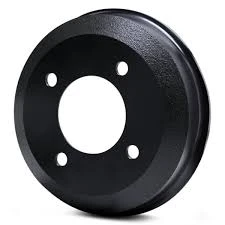Feb . 15, 2025 20:51
Back to list
drum brakes leading and trailing shoes
Drum brakes might seem like relics from the past, but they still play a crucial role in modern automotive applications, particularly in the context of leading and trailing shoes. Understanding their function, design, and advantages can provide invaluable insights for car enthusiasts and industry professionals alike.
However, understanding the mechanics behind drum brakes isn't just about recognizing their strengths. It also involves acknowledging their limitations. One inherent issue is heat dissipation. Drum brakes tend to overheat more easily than disc brakes, as the heat generated is not as easily dispersed. This can lead to brake fade, where effectiveness diminishes after prolonged use. Therefore, they may not be ideal for high-speed, high-performance applications where consistent braking power is a necessity. Despite these challenges, drum brakes are incredibly cost-effective, and their straightforward design allows for easier, less frequent maintenance when compared to their disc counterparts. This is a noteworthy consideration for fleet managers and everyday drivers looking to optimize their vehicle maintenance routines without sacrificing safety and reliability. For automotive engineers and designers, the decision to implement drum brakes with leading and trailing shoes entails examining specific vehicle requirements, including cost constraints, desired performance characteristics, and expected environmental conditions. Embracing this technology requires weighing its compact efficiency against the backdrop of modern performance standards, ultimately reflecting a balanced approach to vehicle design. In conclusion, leading and trailing shoes within drum brake systems embody a proven technology that successfully couples economical design with reliable functionality. While they may not overshadow disc brakes in terms of sheer performance, their continued application highlights their practical relevance in today’s diverse automotive landscape. Their blend of simplicity, durability, and cost-effectiveness ensures that drum brakes remain a viable option for vehicles where premium braking performance is balanced with practicality and efficiency.


However, understanding the mechanics behind drum brakes isn't just about recognizing their strengths. It also involves acknowledging their limitations. One inherent issue is heat dissipation. Drum brakes tend to overheat more easily than disc brakes, as the heat generated is not as easily dispersed. This can lead to brake fade, where effectiveness diminishes after prolonged use. Therefore, they may not be ideal for high-speed, high-performance applications where consistent braking power is a necessity. Despite these challenges, drum brakes are incredibly cost-effective, and their straightforward design allows for easier, less frequent maintenance when compared to their disc counterparts. This is a noteworthy consideration for fleet managers and everyday drivers looking to optimize their vehicle maintenance routines without sacrificing safety and reliability. For automotive engineers and designers, the decision to implement drum brakes with leading and trailing shoes entails examining specific vehicle requirements, including cost constraints, desired performance characteristics, and expected environmental conditions. Embracing this technology requires weighing its compact efficiency against the backdrop of modern performance standards, ultimately reflecting a balanced approach to vehicle design. In conclusion, leading and trailing shoes within drum brake systems embody a proven technology that successfully couples economical design with reliable functionality. While they may not overshadow disc brakes in terms of sheer performance, their continued application highlights their practical relevance in today’s diverse automotive landscape. Their blend of simplicity, durability, and cost-effectiveness ensures that drum brakes remain a viable option for vehicles where premium braking performance is balanced with practicality and efficiency.
Prev:
Next:
Latest news
-
Brake Drums for Trucks | OEM-Grade, Factory DirectNewsNov.10,2025
-
High-Performance Brake Drums for Trucks | OEM & ISONewsNov.10,2025
-
Brake Drums Built to Last — OEM-Grade, Balanced for TrucksNewsNov.10,2025
-
Brake Drums for Trucks – OEM-Grade, Durable, Low NoiseNewsNov.10,2025
-
Brake Drums for Trucks | OEM, ISO-Certified, Fast DeliveryNewsNov.10,2025
-
Brake Drums: OEM-Grade, Precision Balanced, Factory DirectNewsNov.03,2025
-
Brake Drums: Heavy-Duty, OEM-Grade, Precision-BalancedNewsNov.03,2025


